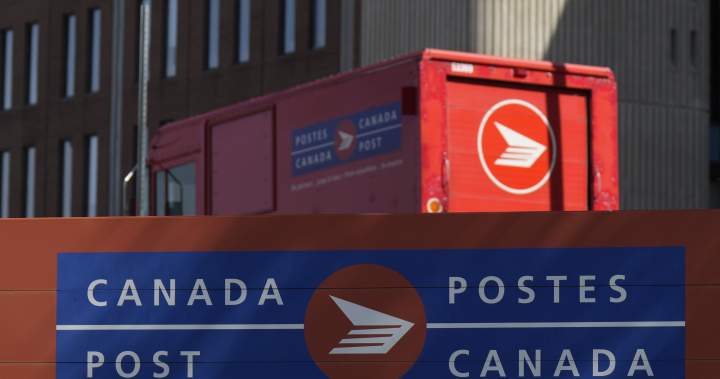A ban on delivering business flyers went into effect Monday morning across Canada, the latest move in a deepening labour dispute between Canada Post and its unionized postal workers.
The Canadian Union of Postal Workers announced the move last week in a bid to force the national mail carrier back to the negotiating table, where talks have once again stalled on a new contract.
“Canada Post needs to get back to the table,” CUPW national president Jan Simpson said at a press conference in Ottawa on Friday.
“If Canada Post continues to stall, postal workers will have no choice but to consider stronger actions to move negotiations ahead.”
No new talks have been scheduled as of Monday.
In the meantime, Canada Post says it is no longer accepting so-called “neighbourhood mail” for drop-off at its facilities after 12:01 a.m. Monday, until further notice. Trucks delivering those flyers for mailing will be turned away, it said, and existing materials will be kept in storage.
The company said Monday that it is “disappointed” in CUPW’s decision, and claimed the flyer delivery ban affects unionized postal workers “who are paid to deliver flyers on top of their wage.”
“This decision impacts the thousands of Canadian businesses that reach their customers with information and offers through the mail,” the Crown corporation said in a statement.
The Canadian Federation of Independent Businesses estimates around 20 per cent of small businesses across the country use mailed flyers to promote store openings and sales, particularly to older demographics and rural communities.
“We are getting calls already from small business owners that have had launches that were about to go out, and now learn that those flyers, those pieces of ad mail, may not get to their end consumers as planned,” CFIB president Dan Kelly told Global News in an interview.

Get breaking National news
For news impacting Canada and around the world, sign up for breaking news alerts delivered directly to you when they happen.
“Consumers, of course, are not going to miss their flyers, but if you depend on them as a low-cost means of marketing, gosh, this can kill your business.”
Canada Post and CUPW last met with federal mediators on Aug. 20, where the union presented its latest counter-offers to the company.
The offers called for higher wage and benefit increases than what Canada Post proposed in May, which it called its “best and final offers.”
A week later, Canada Post said the gap between the two sides remains “substantial” and urged CUPW to “revisit its offers to align with the realities confronting the company,” calling its demands “unaffordable.”
The union claims Canada Post has “abandoned bargaining” to force the union toward accepting its earlier offers, despite postal workers rejecting them in a vote facilitated by the Canada Industrial Relations Board more than a month ago.
“CUPW and Canada Post must put their differences aside and get a deal,” federal Jobs Minister Patty Hajdu’s press secretary Jennifer Kozelj said in an email to Global News on Monday.
“Federal mediators remain available to help them do that.”
The union’s latest offers include a total 19 per cent wage increase over four years, along with a cost-of-living allowance system that triggers additional payments during periods of high inflation. They also call for improvements to benefits and paid leave, but made some allowances for part-time workers.
Canada Post had proposed a 13 per cent wage increase over the same time period, and has insisted on using part-time workers for weekend parcel delivery in order to cut down on operation costs.
The Crown corporation says it’s bleeding millions of dollars a day as uncertainty around labour negotiations hurts its business.
It also says the continued decline of letter mail and the rise of independent parcel delivery competitors have created long-term financial constraints that make it nearly impossible to meet the union’s demands.
An Industrial Inquiry Commission report from commissioner William Kaplan earlier this year found the postal service was effectively bankrupt and needed substantial reforms to remain afloat.
Those findings have been repeatedly highlighted by the company, which posted its “largest loss” ever for a single quarter last month at $407 million before taxes. Since 2018, the company says it has lost over $5 billion.
Kelly notes that calls for the federal government to reform Canada Post and allow it to take certain restructuring steps date back years.
Multiple commissioned reports during that time highlighted by the union, the CFIB and other stakeholders have recommended potential solutions, from closing rural post offices to ending door-to-door delivery to generating revenue through postal banking — all steps that would require approval from Ottawa.
A request for comment from Government Transformation, Public Works and Procurement Minister Joël Lightbound, who now oversees Canada Post, was not immediately returned Monday as Parliament returned from the summer break.
The ongoing dispute is also fuelling fears of another strike as the winter holiday shopping season looms.
A strike and lockout lasted more than a month in November and December last fall, ending only after then-labour minister Steven MacKinnon declared an impasse in the talks and asked the Canada Industrial Relations Board to order an end to the work stoppage.
Canada Post estimates the strike cost the company $208 million, while Kelly says small businesses lost about $1 billion in lost sales and increased costs.
“Goodness knows this one could go on even longer” if postal workers return to the picket line, he said.
“Unless we as taxpayers are going to want to shovel more money into Canada Post just to keep mail delivery alive, I don’t know what the solution is.”
Read the full article here


